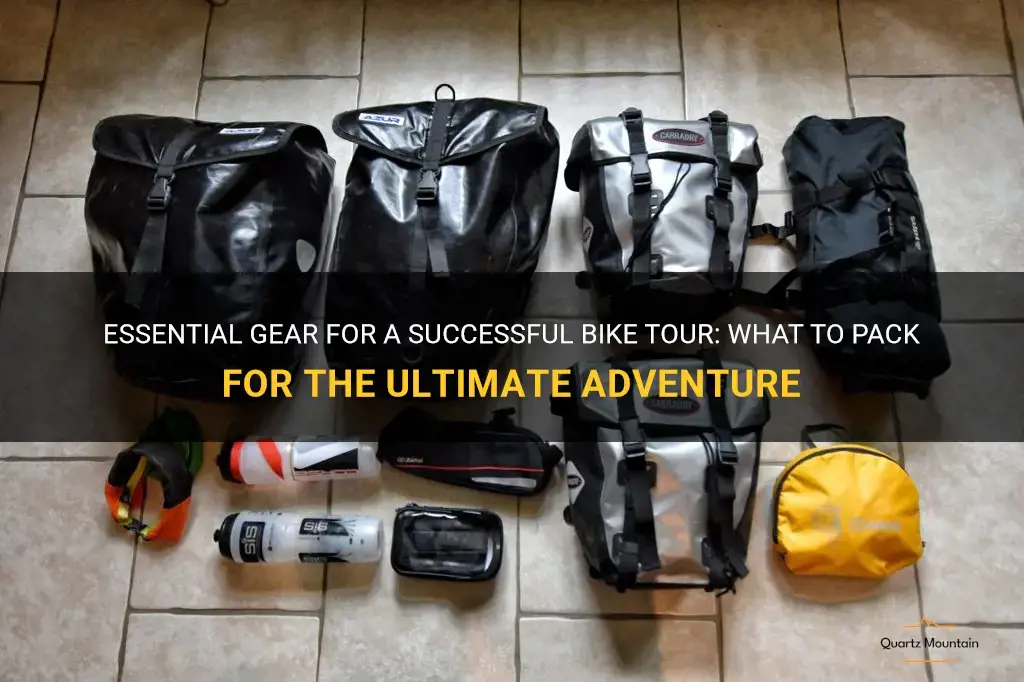
Embarking on a bike tour can be the ultimate adventure for thrill-seekers and outdoor enthusiasts alike. But before you hit the open road on two wheels, it's essential to pack the right gear to ensure a successful trip. From durable backpacks to high-quality cycling apparel, having the right equipment can make all the difference in comfort, safety, and overall enjoyment. In this article, we'll explore the essential gear you need for a successful bike tour, so you can hit the road with confidence and excitement.
| Characteristics | Values |
|---|---|
| Bicycle | Different types of bicycles are suitable for touring depending on the terrain and personal preferences. Some common options include road bikes, touring bikes, mountain bikes, and gravel bikes. |
| Panniers | Panniers are bags specifically designed for bike touring that can be attached to racks. They provide storage space for clothing, gear, food, and other essential items. |
| Tent | A lightweight tent suitable for bike touring is necessary for overnight stays. There are various options available, including one-person or two-person tents. |
| Sleeping Bag | A compact and lightweight sleeping bag is essential for providing warmth and comfort during camping and overnight stays. Consider the temperature rating and packability of the sleeping bag. |
| Sleeping Pad | A sleeping pad provides insulation and cushioning when sleeping on the ground. Look for compact and lightweight options that offer good insulation and comfort. |
| Cooking Equipment | Depending on the tour length and personal preferences, cooking equipment may vary. It can include a camp stove, cooking utensils, pots and pans, and a lightweight fuel source such as a gas canister or alcohol stove. |
| Water Bottles | Staying hydrated is crucial while bike touring. Carry multiple water bottles or hydration packs to ensure a steady supply of drinking water. |
| Clothing | Pack appropriate clothing for various weather conditions. This may include cycling-specific gear like padded shorts, jerseys, and rain jackets, as well as off-bike clothing for rest days. |
| Tools and Spares | Carry essential tools and spares for bike maintenance and repairs. This includes a multi-tool, spare tubes, a patch kit, tire levers, a pump or CO2 inflator, and other tools specific to the bike's components. |
| First Aid Kit | A basic first aid kit with bandaids, antiseptic wipes, pain relievers, and other necessary supplies should be included for any minor injuries or emergencies that may occur during the tour. |
| Maps and Navigation | Depending on the route and personal preference, carry maps or have a GPS device or smartphone with offline maps for navigation. Some touring cyclists also use bike-specific GPS devices for turn-by-turn directions. |
| Bike Lock | A sturdy bike lock is essential to secure the bike when leaving it unattended. Carry a reliable lock that fits your needs and provides peace of mind. |
| Bike Lights | Bike lights are crucial for visibility and safety, especially when riding in low-light conditions or at night. Ensure your bike is equipped with front and rear lights that are visible to other road users. |
| Bike Repair Kit | In addition to the basic tools and spares, carry a bike repair kit that includes items like chain lube, tire patches, spare brake pads, and other components that may require maintenance or replacement during the tour. |
| Personal Essentials | Don't forget personal essentials such as toiletries, sunscreen, insect repellent, personal medications, and any other items specific to your needs. |
| Passport/ID | If bike touring in another country, carry necessary identification such as a passport or ID card for crossing borders or identification purposes. |
| Money/Credit Card | Carry appropriate amounts of cash and a credit or debit card for emergencies or to make purchases during the tour. Ensure they are securely stored in a waterproof and easily accessible place. |
| Electronics | Depending on personal preferences, carry a smartphone, camera, power bank, and any other electronic devices you may need for communication, navigation, entertainment, or capturing memories of the tour. |
| Bike Helmet | Always wear a helmet while bike touring for safety. Choose a reliable and comfortable helmet that fits properly. |
| Sunglasses | Protect your eyes from the sun, wind, and debris with a good pair of sunglasses. Look for options with UV protection and suitable for cycling. |
| Bike Bell | A bike bell can be handy to alert pedestrians or other cyclists of your presence, especially in crowded areas or on shared-use paths. |
| Bike Gloves | Cycling gloves provide padding, grip, and protection to the hands while riding. Choose gloves that fit well and offer the necessary features for your comfort and riding style. |
What You'll Learn
- What are the essential items to pack for a bike touring trip?
- What kind of clothing should I bring for bike touring?
- Are there any specific tools or spare parts I should bring for bike repairs?
- How much food and water should I pack for a bike touring trip?
- Are there any safety items or equipment I should include in my packing list for bike touring?

What are the essential items to pack for a bike touring trip?
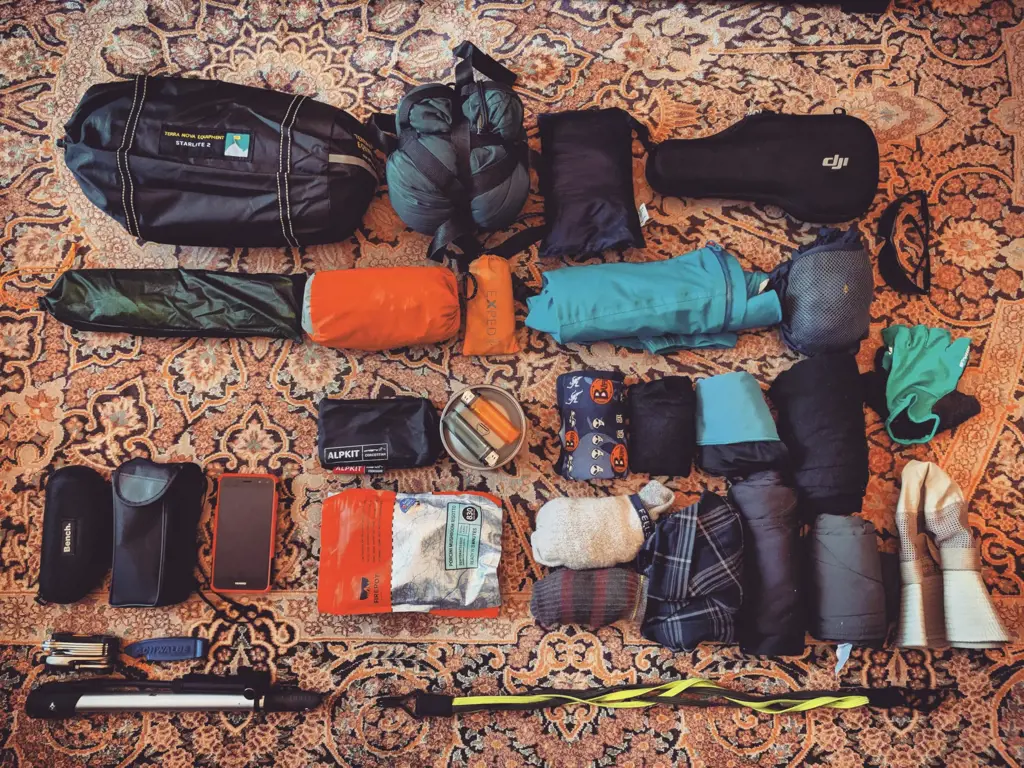
Embarking on a bike touring trip can be an incredibly rewarding experience, but it's important to be well-prepared for the journey ahead. Whether you're planning a short weekend trip or a longer adventure, packing the right gear is essential for a successful and enjoyable trip. In this article, we will explore the essential items to pack for a bike touring trip, taking into consideration both scientific research and experienced cyclists' recommendations.
Bike Repair Kit:
A bike repair kit is perhaps the most crucial item to have on a bike touring trip. It should include spare inner tubes, tire levers, a multi-tool, a chain tool, a pump, and a patch kit. These tools will help you fix any minor mechanical issues that may arise during your journey.
Navigation Tools:
To ensure you don't get lost on your bike tour, it's important to have reliable navigation tools. This can include a GPS device or a mobile phone with a navigation app. Additionally, bringing along a physical map can be useful in case your electronic devices fail or you lose signal.
Camping Gear:
If you plan on camping during your bike tour, you'll need to pack appropriate camping gear. This can include a lightweight tent, a sleeping bag, a camping stove, and cookware. Make sure to choose lightweight options to minimize the extra weight on your bike.
Clothing:
The right clothing is essential to stay comfortable and protected on your bike tour. Consider packing items such as padded cycling shorts, moisture-wicking shirts, waterproof jackets, and comfortable footwear. Don't forget to bring extra socks and gloves for different weather conditions.
Food and Water:
Proper nutrition and hydration are crucial for endurance activities like bike touring. Pack enough food and water for your journey, including energy bars, fruits, nuts, and electrolyte supplements. Depending on your route, you may also need to plan for water refilling stations or water purification systems.
First Aid Kit:
Accidents can happen, so it's important to have a comprehensive first aid kit on hand. Your kit should include bandages, antiseptic wipes, pain relievers, and any personal medications you may need. It's also a good idea to familiarize yourself with basic first aid procedures before your trip.
Safety Gear:
To ensure your safety on the road, be sure to pack reflective clothing, a high-visibility vest, and a front and rear bike light. These items will increase your visibility to other road users, especially during low-light conditions. Additionally, wearing a helmet is essential for protecting yourself in case of a fall or accident.
Personal Items:
Lastly, don't forget to pack personal items such as toiletries, sunscreen, insect repellent, a camera, and a lock for securing your bike. These items will add to your overall comfort and convenience during your bike touring adventure.
In conclusion, packing the right gear is crucial for a successful bike touring trip. Be sure to pack a bike repair kit, navigation tools, camping gear, appropriate clothing, food, water, a first aid kit, safety gear, and personal items. By being prepared and well-equipped, you'll be able to focus on enjoying the journey and making lasting memories.
Essential Gear and Supplies for a Successful Hunting Expedition
You may want to see also

What kind of clothing should I bring for bike touring?
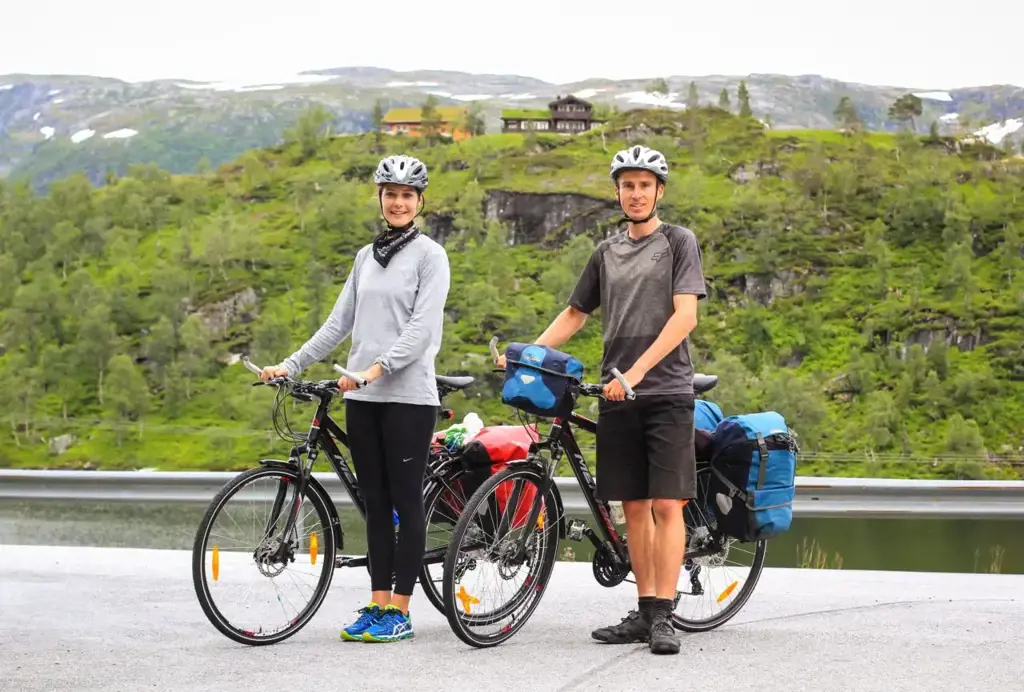
When it comes to bike touring, it is important to choose the right clothing to ensure comfort and functionality throughout your journey. The right clothing can protect you from the elements, provide proper ventilation, and enhance your overall biking experience. In this article, we will discuss what kind of clothing you should bring for bike touring and why it is important.
- Moisture-wicking base layers: Start with a moisture-wicking base layer, which helps to keep you dry and comfortable by pulling sweat away from your skin. Look for base layers made of materials such as merino wool or synthetic blends, as these materials are known for their moisture-wicking properties.
- Cycling jerseys: Cycling jerseys are designed specifically for bike touring and provide a range of features that enhance your biking experience. They are typically made of lightweight and breathable materials that wick away moisture and offer ventilation. Cycling jerseys often have pockets on the back for storing small items such as energy bars and keys.
- Cycling shorts: Invest in a good pair of cycling shorts with a padded chamois. The padded chamois helps to reduce friction and provide extra cushioning, making long rides more comfortable. Look for shorts made with moisture-wicking materials and a good fit to prevent chafing and discomfort.
- Cycling tights or leg warmers: Depending on the weather conditions, you may want to bring cycling tights or leg warmers. These can provide additional warmth and protection in cooler temperatures. Look for tights or leg warmers made of materials that offer good insulation while still allowing for breathability.
- Windproof and waterproof jackets: It is important to be prepared for changing weather conditions when bike touring. Bring a lightweight and packable windproof jacket that can protect you from gusts of wind. Additionally, consider a waterproof jacket to protect you from rain showers. Look for jackets with taped seams and ventilation features to prevent sweat buildup.
- Arm and leg warmers: Arm and leg warmers are versatile pieces of clothing that can be added or removed as needed. They provide warmth and protection in cooler temperatures and can easily be rolled up and stored in your jersey pocket when not in use. Look for warmers made of materials that offer good insulation and breathability, and ensure a snug fit to prevent slippage.
- Socks and gloves: Invest in a good pair of cycling socks made of moisture-wicking materials to keep your feet dry and comfortable. Additionally, bring gloves that offer padding and grip to reduce hand fatigue and enhance your grip on the handlebars.
- Helmet and sunglasses: Don't forget to bring a well-fitted helmet to protect your head during your bike tour. It is also important to bring sunglasses to protect your eyes from the sun, wind, and debris.
In conclusion, when packing for a bike tour, prioritize clothing that is comfortable, functional, and weather-appropriate. Invest in moisture-wicking base layers, cycling jerseys, shorts with a padded chamois, windproof and waterproof jackets, arm and leg warmers, socks, gloves, a well-fitted helmet, and sunglasses. By choosing the right clothing, you can ensure a comfortable and enjoyable bike touring experience.
Essential Packing Tips for Your Trip to Kauai
You may want to see also

Are there any specific tools or spare parts I should bring for bike repairs?
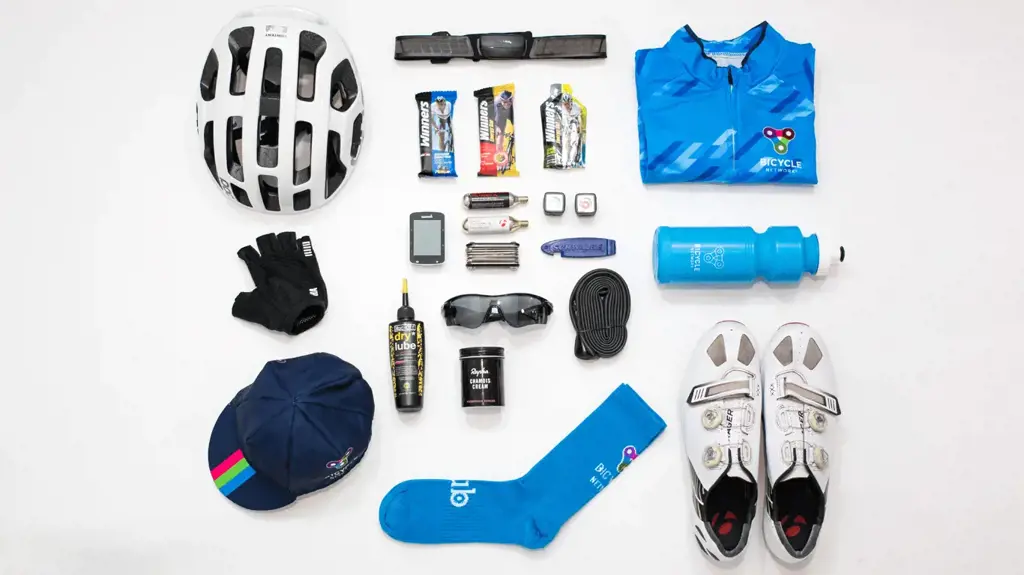
When going on a bike ride, it is always a good idea to be prepared for any repairs you may need to make along the way. This includes bringing specific tools and spare parts that could come in handy in case of any mechanical issues. Here are some tools and spare parts that you should consider bringing with you on your bike rides:
- Multi-tool: A multi-tool is an essential item for any cyclist. It typically includes Allen keys of different sizes, a screwdriver, and a chain tool. This tool can be used for a wide range of repairs, from adjusting your seat height to fixing a loose bolt.
- Tire levers: Tire levers are used to remove the tire from the rim when fixing a flat. They come in pairs and are lightweight and easy to carry. Having a few tire levers in your bike bag can save you a lot of time and effort when changing a flat tire.
- Spare inner tube: Flats happen, and having a spare inner tube can be a lifesaver. Make sure to carry a tube that is compatible with your bike's tire size. If you have a puncture, you can quickly change the tube and be back on the road in no time.
- Patch kit: Along with a spare tube, it is also a good idea to carry a patch kit. Patch kits consist of rubber patches and adhesive, allowing you to repair punctures without having to replace the entire tube. Patch kits are small and lightweight, making them easy to carry in your bike bag.
- Pump: A portable bike pump is an essential tool for maintaining the tire pressure of your bike. There are many options available, including mini pumps that can be attached to your bike frame or carried in a bag. Look for a pump that is compatible with both Presta and Schrader valves, which are the two most common valve types.
- Chain lubricant: Keeping your chain well-lubricated is crucial for smooth gear shifting and preventing wear and tear. Carrying a small bottle of chain lubricant can help you maintain your bike's drivetrain during long rides. Apply the lubricant to the chain every few hundred miles or whenever it starts to feel dry.
- Spare bolts and nuts: It's always a good idea to have a few spare bolts and nuts of various sizes in case any become loose or go missing. These small parts can often be the cause of annoying mechanical issues, so having some spares on hand can save you a lot of frustration.
- Cable and housing: If you have a bike with cable-actuated brakes or gears, carrying some spare cable and housing can be useful. Over time, cables can become frayed or housing can become worn, causing poor performance or even failure. Having a spare set on hand can ensure you can quickly replace any damaged components.
Remember, these are just some of the tools and spare parts that you may find useful on your bike rides. The specific tools and parts you need will depend on the type of bike you have and the length and location of your rides. It's always a good idea to do some research and consult with experienced cyclists to determine the best tools and spare parts to carry with you.
Essential Items to Pack for a Successful VidCon Experience
You may want to see also

How much food and water should I pack for a bike touring trip?
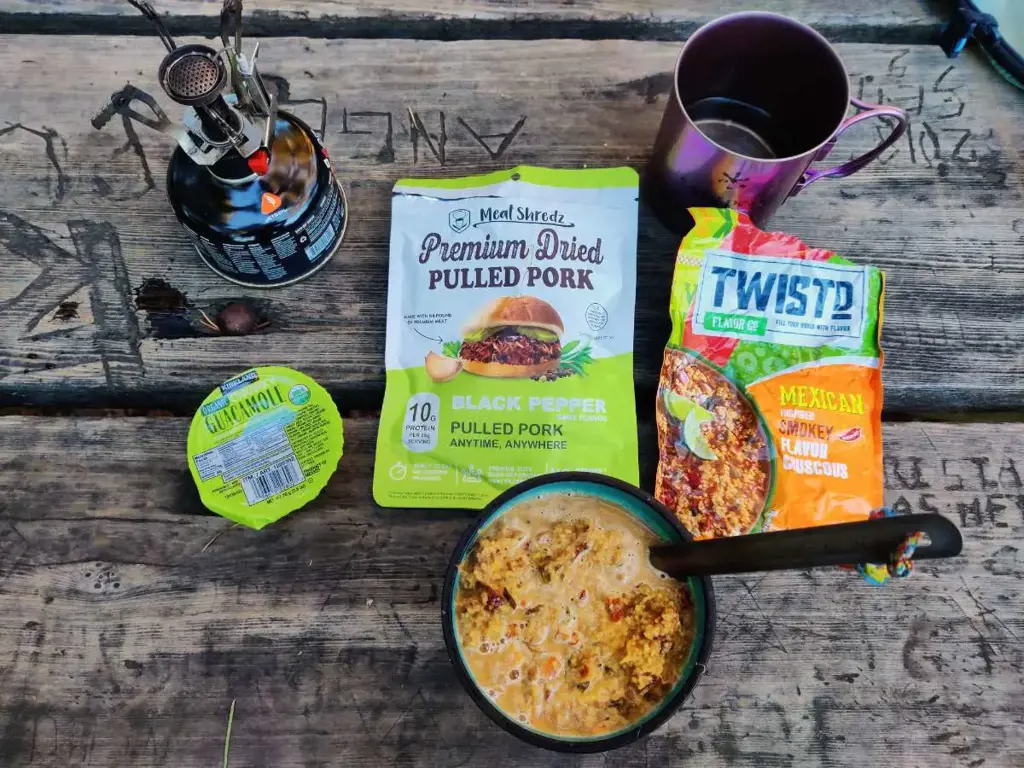
When planning a bike touring trip, it is essential to pack enough food and water to sustain yourself throughout your journey. The amount of food and water you should pack will depend on various factors such as the duration of your trip, the intensity of your cycling, and the availability of food and water along your route. In this article, we will discuss how much food and water you should pack for a bike touring trip.
Determine your daily caloric needs:
Before you can calculate the amount of food you need to pack, you must first determine your daily caloric needs. Your caloric needs will depend on your body weight, metabolism, and the intensity of your cycling. As a general guideline, most cyclists require anywhere between 2,000 to 4,000 calories per day. It is essential to consider factors such as the terrain you will be covering, as hilly or mountainous routes can significantly increase your caloric needs.
Pack calorie-dense, lightweight food:
When selecting food items to pack for your bike touring trip, opt for calorie-dense, lightweight options. This will help minimize the weight of your gear while ensuring you have enough energy to sustain your cycling. Examples of calorie-dense foods include energy bars, nuts and seeds, dried fruits, nut butter, and dehydrated meals. These foods pack a lot of calories into a small volume, making them ideal for bike touring.
Consider meal planning:
Rather than packing a random assortment of food items, consider meal planning for your trip. This involves pre-planning your meals and snacks, ensuring you have a balanced diet and enough variety to keep you satisfied. Take into account the number of meals you will need each day and plan accordingly. Aim for a mix of carbohydrates, proteins, and healthy fats to provide sustained energy while cycling.
Pack extra snacks:
It's always a good idea to pack some extra snacks for unexpected delays or emergencies. Energy bars, trail mix, and jerky are excellent options as they are compact and provide a quick source of energy. When packing extra snacks, consider the duration of your trip and the availability of food along your route. If you are cycling through remote areas with limited access to food, it's better to pack more snacks.
Hydration is key:
In addition to food, it is crucial to pack enough water for your bike touring trip. The amount of water you should pack will depend on the availability of water sources along your route. If you are cycling through areas with frequent access to water, you may only need to pack a minimal amount for emergencies. However, if you are traveling through arid regions or remote areas with limited water sources, it is essential to pack enough water to sustain yourself between refill opportunities. As a general guideline, it is recommended to drink about 0.5 to 1 liter of water per hour of cycling, depending on the weather conditions and exertion level.
In conclusion, when packing food and water for a bike touring trip, it is vital to consider your caloric needs, the duration and intensity of your cycling, and the availability of food and water along your route. By planning your meals, packing calorie-dense, lightweight foods, and considering hydration needs, you can ensure you have enough sustenance to enjoy your bike touring adventure. Remember to always pack some extra snacks and adapt your food and water packing accordingly based on the specifics of your trip.
Choosing the Right Terminals for DIY Lithium Battery Packs
You may want to see also

Are there any safety items or equipment I should include in my packing list for bike touring?
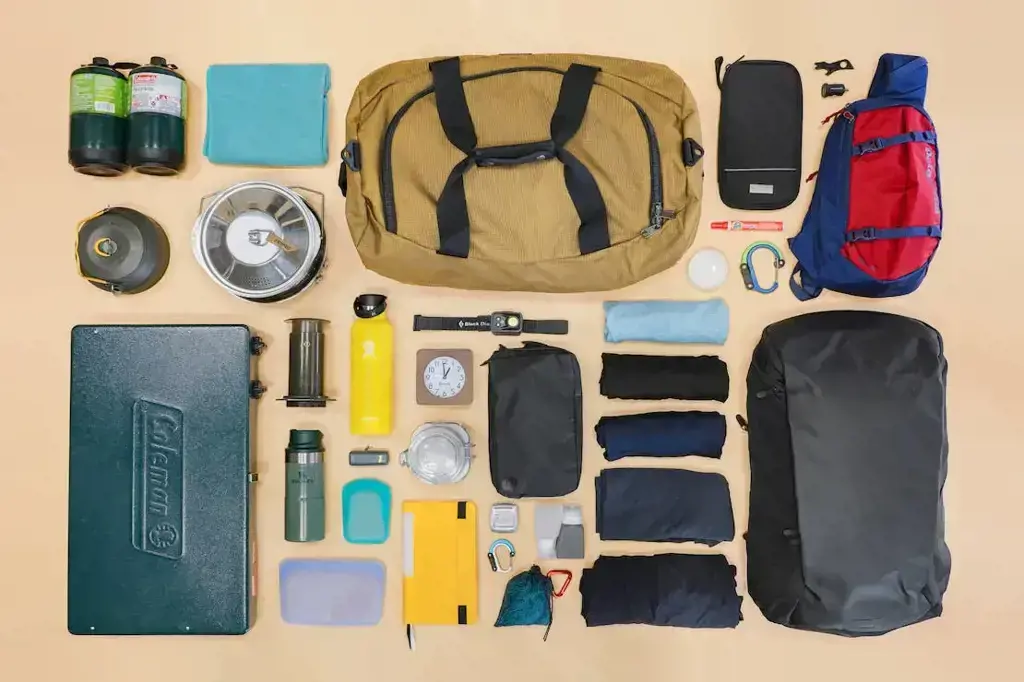
Bike touring can be an exciting and adventurous way to explore new places. However, it's important to prioritize safety while on the road. Whether you are an experienced cyclist or a beginner, there are a few essential safety items and equipment that you should include in your packing list for bike touring. These items will ensure that you are prepared for any unforeseen circumstances and can handle emergencies effectively.
- Helmet: A good-quality helmet is a must-have for any cyclist, especially when embarking on a bike tour. It protects your head in case of a fall or accident, reducing the risk of serious head injuries. Make sure your helmet fits properly and is in good condition before setting off.
- Reflective gear: Visibility is crucial when cycling, especially in low-light conditions or at night. Pack reflective gear such as a reflective vest, ankle bands, or reflective tape for your bike. These will make you more visible to drivers and other cyclists, reducing the risk of accidents.
- Lights: Having bright front and rear lights on your bike is essential for night riding or cycling in low-light conditions. Lights not only help you see the road ahead but also make you more visible to others on the road. Ensure that your lights are fully charged or have spare batteries available.
- First aid kit: Accidents can happen on the road, so it's important to have a well-stocked first aid kit with you. Include items such as band-aids, antiseptic ointment, tweezers, and pain relievers. Familiarize yourself with basic first aid procedures before your bike tour.
- Bike lock: When you take breaks or stop to explore, having a reliable bike lock will give you peace of mind. Invest in a sturdy lock that can secure your bike to a fixed object, minimizing the risk of theft.
- Repair tools: Flat tires, loose bolts, and other mechanical issues can occur during a bike tour. Carry a basic repair kit that includes tire patches, a spare tube, tire levers, a multi-tool, and a mini-pump. Familiarize yourself with basic bike repairs and maintenance before your trip.
- Maps or GPS: Navigation is important when touring unfamiliar areas. Carry a detailed map or a GPS device to help you find your way. Make sure to have spare batteries or a portable charger for your electronic devices.
- Personal identification and emergency contact information: Always carry identification, such as your driver's license or passport, in case of emergencies. Additionally, have a list of emergency contact numbers and any relevant medical information with you.
- Water and snacks: Staying hydrated and fueled is essential during long bike rides. Carry enough water and snacks to keep you energized throughout the day. Consider packing electrolyte tablets to replenish important minerals lost through perspiration.
- Insurance and documentation: If you're traveling internationally or planning an extended tour, it's a good idea to have travel insurance that covers any medical emergencies or bike-related incidents. Keep a copy of your insurance policy and any important documents in a waterproof bag.
Remember, safety should always be a priority during bike touring. Along with the essential items mentioned above, it's important to ensure that your bike is in good working condition before your tour. Regularly check the brakes, gears, and tire pressure, and perform any necessary maintenance or repairs. By being prepared and taking necessary precautions, you can enjoy a safe and enjoyable bike touring experience.
The Ultimate Checklist for Packing Your Hospital Bag for Delivery
You may want to see also
Frequently asked questions
When going on a bike tour, it's important to pack essential gear that will make your trip comfortable and safe. Some must-haves include a tent or sleeping bag, a backpack or panniers for storage, a repair kit with tools, spare tubes, and a pump, a first aid kit, a bike lock, a water bottle, a helmet, and appropriate clothing for the weather conditions.
The amount of food and water you should pack for a bike tour depends on the length of your trip and the availability of resources along your route. It's generally recommended to pack enough food for each day of your trip, plus a little extra in case of emergencies. Aim for high-energy, non-perishable foods like nuts, dried fruits, energy bars, and freeze-dried meals. As for water, carry enough for the distance between reliable water sources, and use water purification methods if necessary.
When packing clothing for a bike tour, consider the weather conditions you'll encounter along your route. Pack lightweight, moisture-wicking clothing that can be layered for warmth. Don't forget essentials like padded cycling shorts, comfortable socks, and a rain jacket. It's also a good idea to pack a few extra pairs of gloves, as they can wear out quickly on long rides.
Whether you need to pack camping gear for your bike tour depends on your personal preferences and the availability of accommodation options along your route. Camping can be a cost-effective and flexible option, allowing you to set up camp wherever you choose. However, there are alternative options like youth hostels, hotels, or staying with locals through hospitality networks. Consider your preferences and the resources available to you when deciding on accommodation options for your bike tour.







